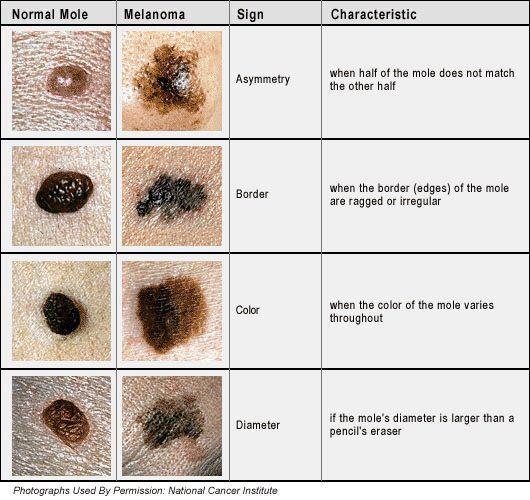When caught early, melanoma is highly curable. If you have or suspect you have a skin problem, please consult with a dermatologist, or other qualified professional healthcare provider.
Definition of Melanoma
A form of cancer that begins in melanocytes (cells that make the pigment melanin). It may begin in a mole (skin melanoma), but can also begin in other pigmented tissues, such as in the eye or in the intestines.

CDC’s skin cancer website:
Cancer Data Visualization Tool (includes melanoma incidence and mortality)
Data Explorer (UV data).
2019 YRBS data (including indoor tanning and sunburn).
- ACS released its 2024 United States Cancer Facts and Figures. The rates of melanoma have been rising for the last 30 years.
- The number of new melanoma cases is projected to increase to 100,640 as compared to:
- 2023 at 97,610
- 2019 at 96,480
- 2018 at 91,270
- 2017 at 87,110
- 2016 at 76,380
- 2015 at 73,870
- An estimated 7,990 deaths from melanoma are expected in the US, comprised of 5,420 men and 2,570 women.
- The number of new melanoma cases is projected to increase to 100,640 as compared to:
 What Does Melanoma Look Like
What Does Melanoma Look Like
Free Booklet: What You Need to Know About Melanoma and Other Skin Cancer.
Melanoma is a very serious form of skin cancer. Although accounting for only 4% of total skin cancer cases, it is the leading cause of skin cancer related deaths. The risk of developing melanoma is increasing, and most frighteningly, the cases of melanoma amongst young children are on the rise. The main cause of melanoma is believed to be spending too much time in the sun, which results in exposure to ultraviolet (UV) radiation. People with fair skin and lighter hair (those that tend to sunburn easily) are at greatest risk, but anyone who is exposed to large amounts of sunlight is at risk.
You may be at a higher risk for developing melanoma if you have at least 5 of the criteria below. Talk to family members and your doctor about whether you are at an increased risk and the steps you can take to prevent melanoma.
- Fair skin, light hair color, light eye color: Light skin, blonde or red hair, and blue eyes provide less protection against damaging UV rays; however, having dark skin, hair and eyes does not eliminate your risk
- Tanning bed use: Tanning bed use before the age of 30 increases your risk of melanoma by 75 percent. Learn more about why tanning is dangerous.
- Exposure to UV radiation: Whether it’s from natural or artificial sources, limiting your UV exposure will help decrease your risk of getting melanoma
- Family history of melanoma: If one or more of your immediate family members has been diagnosed, this increases your chance of a diagnosis
- Sunburns at a young age: Just one blistering sunburn at a young age doubles your chances of a diagnosis
- High number of moles: Individuals with 50+ moles have an increased risk
- Previous melanoma diagnosis: A previous diagnosis increases your risk of a recurrence
- Weakened immune system: Certain cancers and illnesses that weaken your immune system can place you at an increased risk
- Previous non-melanoma skin cancer diagnosis: If you have been diagnosed with basal or squamous cell carcinoma in the past, you are at increased risk
- Age: Melanoma is most common in men over the age of 50 (more common than colon, prostate and lung cancer). Melanoma is the second most common cancer in teens and young adults and is the most common type of cancer for young adults.
- Take care! Melanoma is the leading cause of cancer death in women 25 to 30 years old and the second leading cause of cancer death in women 30 to 35 years old.
CDC: Indoor Tanning Dangers. Refer to our Educational Page for additional resources.
Melanoma is epidemic. Melanoma is one of the fastest growing cancers in the U.S. and worldwide.
- With a 1 in 50 lifetime risk of developing melanoma, nearly 87,000 Americans were expected to be diagnosed with the disease in 2017, resulting in over 9,900 deaths.
- In 2009, nearly 63,000 people were diagnosed with melanoma in the U.S., resulting in about 8,650 deaths. In 1935, the disease struck only one in 1,500.
- People under 30 are developing melanoma at an alarming rate – the incidence soaring by 50% in young women since 1980.
- Melanoma is the most common form of cancer for young adults aged 25-29 & the second most common cancer in adolescents and young adults aged 15-29.
- Every 8 minutes, someone in the U.S. will be diagnosed with melanoma.
- Every hour of every day, someone will die from the disease.
- One person dies every hour from melanoma.
- Melanoma is the most common cancer in women ages 25-29 and second only to breast cancer in women 30-34.
- Even though sunburn at any age causes melanoma, eighty percent of sun damage happens before age 18.
- Melanoma costs over $800 million dollars to treat annually.
- Melanoma happens almost equally in the sexes: in 2003, 29,900 men had melanoma and 24,300 women had melanoma.
- The death rate from melanoma for men is almost twice that of women due to late detection.
- Nearly 90% of melanomas are thought to be caused by exposure to UV light and sunlight.
About 5% to 10% of melanomas are found first in internal areas of the body, such as lymph nodes or internal organs, without any obvious signs on the skin.Some doctors believe that most of these melanomas originate on the skin and arise from:
- Melanomas of the skin that were incompletely removed
- “Regressed” melanomas: when your body’s immune system may have destroyed a portion of the cancerous cells in a skin melanoma but not before some melanoma cells were able to get into lymph nodes or blood vessels
- Pigmented cells that traveled to the lymph nodes and were transformed into melanoma
Ocular melanoma is melanoma found in the eye, and is relatively uncommon, accounting for only 3% of all melanoma cases. However, ocular melanoma is the most common type of primary intraocular cancer (tumor started in the eye) in adults. It begins when pigmented (colored) cells in the eye called melanocytes grow uncontrollably. Intraocular melanoma is also called uveal melanoma because it occurs in the part of the eye called the uvea.Ocular melanomas occur in five distinct sites around and in the eye. Each type has its own distinctive growth pattern and prognosis:
- Eyelid Melanoma – Essentially like other skin (cutaneous) melanomas
- Conjunctival Melanoma – The filmy white covering of the eye
- Iris Melanoma – The colored part of the inside of the eye around the pupil
- Choroidal Melanoma – The pigmented supporting layer under the retina containing large numbers of blood vessels
- Optic Nerve Melanoma – The large ‘nerve of vision’ which exits the back of the eye
Basal Cell Carcinoma
- Most common type of skin cancer in fair-skinned people
- Grows very slowly and very rarely will spread to other parts of the body
- Usually found on face, ears, scalp, neck, or upper body
- Can appear as: a red patch, a pink, red, or white bump that is shiny or pearly, an open sore that will not heal, a scar-like area.
Squamous Cell Carcinoma
- Second most-common type of skin cancer in fair-skinned people
- Slow-growing but can spread to other parts of the body
- Twice as common in men as in women
- May appear as a bump or scaly red patch on the face, neck, arms, scalp, ears, lips, or mouth
- Squamous-cell carcinoma of the lips is strongly associated with smoking or use of chewing tobacco and spreads much more frequently than other cancer types.
Benign Lesions
- Moles [medical term: nevus or nevi (plural)]: evenly-colored, even borders, tan or dark brown
- Congenital nevi: present at birth or within first year
- Atypical nevi: moles that are large or have an irregular shape or blurred border; may be pink, brown, or black
- Freckles: small, tan, flat spots caused by chronic or intense sun exposure. The presence of freckles is a marker for the amount of sun damage one has had.
- Lentigines: called sunspots, age spots, or liver spots; flat brown and do not fade like freckles when not in sun. People with lentigines have had a great deal of sun exposure and are at higher risk for skin cancers.
- Seborrheic keratosis: raised, rough, scaly lesions that are usually light brown to almost black in color. They are caused by an excessive growth of the upper layers of the skin. They do not turn into melanoma. They are usually found on the back, chest, arms, and face.